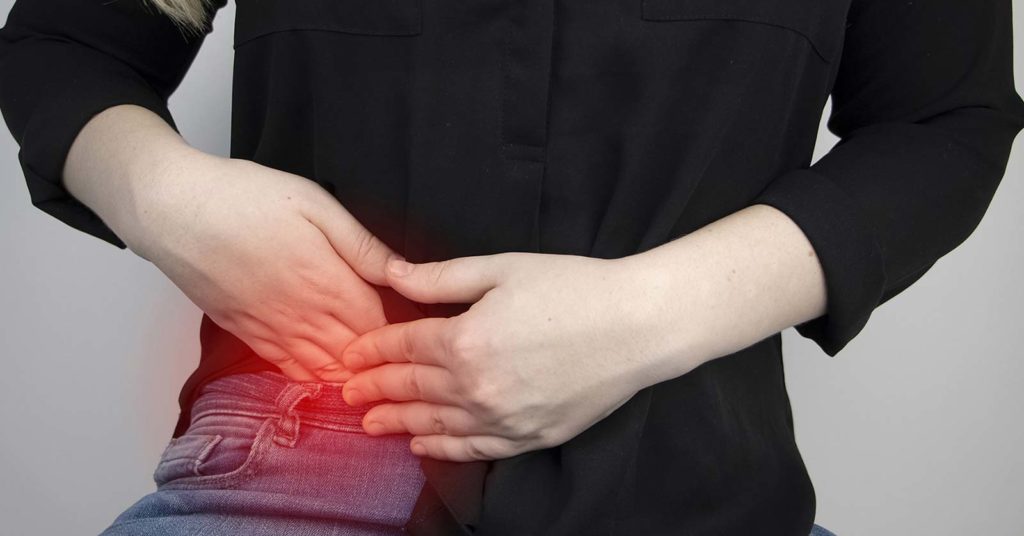
There are different but similar symptoms between Ulcerative Colitis and Crohn’s Disease, both are a kind of inflammatory bowel disease. They both include inflammation in your digestive system. It’s important to know which symptoms frequent which disease as Crohn’s can be more complex to treat. The difference lies mainly in the location of the distress in the gastrointestinal tract and how each of these reacts to the treatment. (Kerr, 2020)
Ulcerative Colitis
Ulcerative Colitis is a disease that causes ulcers and inflammation in your digestive tract, affecting the innermost lining of the large intestine and rectum. There’s no cure but the symptoms can be treated, which can lead to long-term remission. (Mayo Clinic, 2021)
Symptoms of ulcerative colitis vary in severity. They include:
- Abdominal pain
- Diarrhea, often with blood
- Rectal pain
- Rectal Bleeding
- Weight loss
- Loss of appetite
- Urgency of bowel movement
- Fatigue
- Fever
- Malnutrition
(Kerr, 2021)
Possible complications of Ulcerative Colitis are severe bleeding, severe hydration, holes in the colon, inflammation of the joints, skin and eyes, increased risk of colon cancer, a rapidly swelling colon and increased risk of blood clots in veins and arteries. Inflammation spreads to the deepest levels of the bowel and can be painful and sometimes be life-threatening, if not treated. (Mayo Clinic, 2020)
Symptoms of Crohn’s Disease include:
- Frequent Diarrhea
- Abdominal Pain
- Fever
- Blood in the stool
- Occasional constipation
- Weight loss
- Fatigue
- Joint pain
(Kerr, 2020)
In severe cases of Crohn’s Disease, the symptoms can include inflammation of the liver or bile ducts, inflammation of eyes, joints, and skin, anemia (iron deficiency), kidney stones, delayed growth or sexual development in children (Mayo Clinic, 2020)
Possible complications of Crohn’s Disease include bowel obstruction, fistulas, anal fissure, ulcers, malnutrition, colon cancer and increased risk of blood clots in the veins and arteries. (Mayo Clinic, 2020)
Differences between Ulcerative Colitis and Crohn’s Disease
While the symptoms are similar, the key differences between the two inflammatory bowel diseases are:
Location: While ulcerative colitis occurs only in the large intestine, Crohn’s Disease can occur anywhere in the gastrointestinal tract, from the mouth to the anus. (Mayo Clinic, 2020)
Inflammation: There are no healthy spots between the inflammation for people with ulcerative colitis. However, there are healthy areas in between inflamed spots for people suffering from Crohn’s Disease. (Ratini, 2020)
Layers Affected: Doctors see more issues among people with Crohn’s Disease since it can affect any part of the gastrointestinal tract. These are usually not spotted in people with Ulcerative Colitis. Some of these symptoms include anal tears, fissures, narrowing or infections, mouth sores along the sides or bottom of the tongue or between the gums and lower lip. (Ratini, 2020)
Diagnosis of Ulcerative Colitis and Crohn’s Disease
The right diagnosis is important as both diseases have similar symptoms. Different ways for doctors to diagnose it correctly include:
- X-rays or Contrast X-rays that show which parts of the intestine have been affected
- CT scans and MRIs to ensure its inflammatory bowel disease and rule out other diseases with similar symptoms
- Endoscopy, a procedure in which a tiny camera is inserted into your digestive system to get a clear look
- Scientists are also trying to improve several blood tests to make it better at diagnosing Ulcerative Colitis and Crohn’s Disease (Ratini, 2020)
Treatment of Ulcerative Colitis and Crohn’s Disease
Common treatment for both includes medicines that get the inflammation under control and lifestyle changes. These include quitting smoking, changing your diet, regular exercise and avoiding certain pain medication like ibuprofen and more. It is also recommended to reduce stress and relax.
Ulcerative Colitis can go into remission with mild treatment for the symptoms. However, complete remission is uncommon for Crohn’s Disease. Surgery is a possibility in the case of blockage in the digestive tract or a hole or tears in the intestine. (Ratini, 2020)
Stay Vigilant
In the case of both these diseases, it is essential to get frequent check-ups which may mean regular colonoscopies or endoscopies. It’s best to keep a check on your symptoms at all times, and even if the symptoms do start to ease up, continue to stay in contact with your doctor to keep bloodwork and tests up to date.
Works Cited
“Ulcerative Colitis.” Mayo Clinic, Mayo Foundation for Medical Education and Research, 23 Feb. 2021, www.mayoclinic.org/diseases-conditions/ulcerative-colitis/symptoms-causes/syc-20353326#:~:text=Ulcerative%20colitis%20(UL%2Dsur%2D,over%20time%2C%20rather%20than%20suddenly.
“Crohn’s Disease.” Mayo Clinic, Mayo Foundation for Medical Education and Research, 13 Oct. 2020, www.mayoclinic.org/diseases-conditions/crohns-disease/symptoms-causes/syc-20353304#:~:text=Crohn’s%20disease%20and%20ulcerative%20colitis%20are%20both%20forms%20of%20inflammatory,colitis%20affects%20only%20the%20colon.
Ratini, Melinda. “Crohn’s and Colitis: What’s the Difference?” WebMD, WebMD, www.webmd.com/ibd-crohns-disease/crohns-disease/crohns-colitis-difference.
